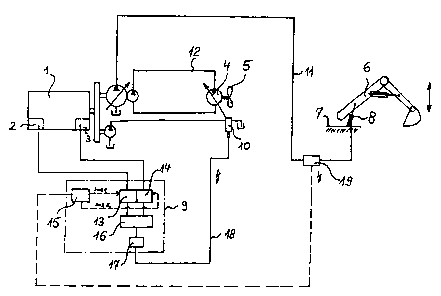Une partie des informations de ce site Web a été fournie par des sources externes. Le gouvernement du Canada n'assume aucune responsabilité concernant la précision, l'actualité ou la fiabilité des informations fournies par les sources externes. Les utilisateurs qui désirent employer cette information devraient consulter directement la source des informations. Le contenu fourni par les sources externes n'est pas assujetti aux exigences sur les langues officielles, la protection des renseignements personnels et l'accessibilité.
L'apparition de différences dans le texte et l'image des Revendications et de l'Abrégé dépend du moment auquel le document est publié. Les textes des Revendications et de l'Abrégé sont affichés :
| (12) Demande de brevet: | (11) CA 2426452 |
|---|---|
| (54) Titre français: | PROCEDE ET DISPOSITIF DE REGLAGE D'UN ENTRAINEMENT DE VENTILATEUR SUR UN MOTEUR A COMBUSTION INTERNE DANS DES MACHINES-OUTILS ET/OU MACHINES DE CONSTRUCTION |
| (54) Titre anglais: | METHOD AND DEVICE FOR REGULATION OF A COOLING FAN DRIVE ON AN INTERNAL COMBUSTION ENGINE IN A CONSTRUCTION OR WORKING MACHINE |
| Statut: | Réputée abandonnée et au-delà du délai pour le rétablissement - en attente de la réponse à l’avis de communication rejetée |
| (51) Classification internationale des brevets (CIB): |
|
|---|---|
| (72) Inventeurs : |
|
| (73) Titulaires : |
|
| (71) Demandeurs : |
|
| (74) Agent: | MACRAE & CO. |
| (74) Co-agent: | |
| (45) Délivré: | |
| (86) Date de dépôt PCT: | 2001-09-05 |
| (87) Mise à la disponibilité du public: | 2003-04-24 |
| Licence disponible: | S.O. |
| Cédé au domaine public: | S.O. |
| (25) Langue des documents déposés: | Anglais |
| Traité de coopération en matière de brevets (PCT): | Oui |
|---|---|
| (86) Numéro de la demande PCT: | PCT/EP2001/010193 |
| (87) Numéro de publication internationale PCT: | WO 2002020955 |
| (85) Entrée nationale: | 2003-04-24 |
| (30) Données de priorité de la demande: | ||||||
|---|---|---|---|---|---|---|
|
L'invention concerne un procédé de réglage d'un entraînement de ventilateur sur un moteur à combustion interne, équipé en particulier de plusieurs circuits de refroidissement indépendants, dans des machines-outils et/ou machines de construction. Selon ce procédé, la consommation de l'entraînement de ventilateur est réglée à environ zéro à certains cycles de travail prédéfinis de la machine-outil et/ou machine de construction et cette consommation est ajoutée à la capacité relative au cycle de travail.
The invention relates to a method for regulation of a cooling fan drive on an
internal combustion engine, in particular equipped with several independent
cooling circuits, in a construction or working machine, whereby the power
drain of the cooling fan drive is set to approximately zero during certain
working stages of the construction and/or working and said power drain may be
added to the capacity for the working stage.
Note : Les revendications sont présentées dans la langue officielle dans laquelle elles ont été soumises.
Note : Les descriptions sont présentées dans la langue officielle dans laquelle elles ont été soumises.

2024-08-01 : Dans le cadre de la transition vers les Brevets de nouvelle génération (BNG), la base de données sur les brevets canadiens (BDBC) contient désormais un Historique d'événement plus détaillé, qui reproduit le Journal des événements de notre nouvelle solution interne.
Veuillez noter que les événements débutant par « Inactive : » se réfèrent à des événements qui ne sont plus utilisés dans notre nouvelle solution interne.
Pour une meilleure compréhension de l'état de la demande ou brevet qui figure sur cette page, la rubrique Mise en garde , et les descriptions de Brevet , Historique d'événement , Taxes périodiques et Historique des paiements devraient être consultées.
| Description | Date |
|---|---|
| Demande non rétablie avant l'échéance | 2006-09-05 |
| Le délai pour l'annulation est expiré | 2006-09-05 |
| Réputée abandonnée - omission de répondre à un avis sur les taxes pour le maintien en état | 2005-09-06 |
| Lettre envoyée | 2003-11-12 |
| Exigences de rétablissement - réputé conforme pour tous les motifs d'abandon | 2003-10-24 |
| Réputée abandonnée - omission de répondre à un avis sur les taxes pour le maintien en état | 2003-09-05 |
| Inactive : Page couverture publiée | 2003-06-27 |
| Lettre envoyée | 2003-06-23 |
| Inactive : Notice - Entrée phase nat. - Pas de RE | 2003-06-23 |
| Demande reçue - PCT | 2003-05-22 |
| Exigences pour l'entrée dans la phase nationale - jugée conforme | 2003-04-24 |
| Demande publiée (accessible au public) | 2003-04-24 |
| Date d'abandonnement | Raison | Date de rétablissement |
|---|---|---|
| 2005-09-06 | ||
| 2003-09-05 |
Le dernier paiement a été reçu le 2004-08-24
Avis : Si le paiement en totalité n'a pas été reçu au plus tard à la date indiquée, une taxe supplémentaire peut être imposée, soit une des taxes suivantes :
Veuillez vous référer à la page web des taxes sur les brevets de l'OPIC pour voir tous les montants actuels des taxes.
| Type de taxes | Anniversaire | Échéance | Date payée |
|---|---|---|---|
| Taxe nationale de base - générale | 2003-04-24 | ||
| Rétablissement (phase nationale) | 2003-04-24 | ||
| Enregistrement d'un document | 2003-04-24 | ||
| TM (demande, 2e anniv.) - générale | 02 | 2003-09-05 | 2003-10-24 |
| Rétablissement | 2003-10-24 | ||
| TM (demande, 3e anniv.) - générale | 03 | 2004-09-07 | 2004-08-24 |
Les titulaires actuels et antérieures au dossier sont affichés en ordre alphabétique.
| Titulaires actuels au dossier |
|---|
| TEREX GERMANY GMBH & CO. KG |
| Titulaires antérieures au dossier |
|---|
| HERBERT ZIPLIES |
| UWE ESCH |